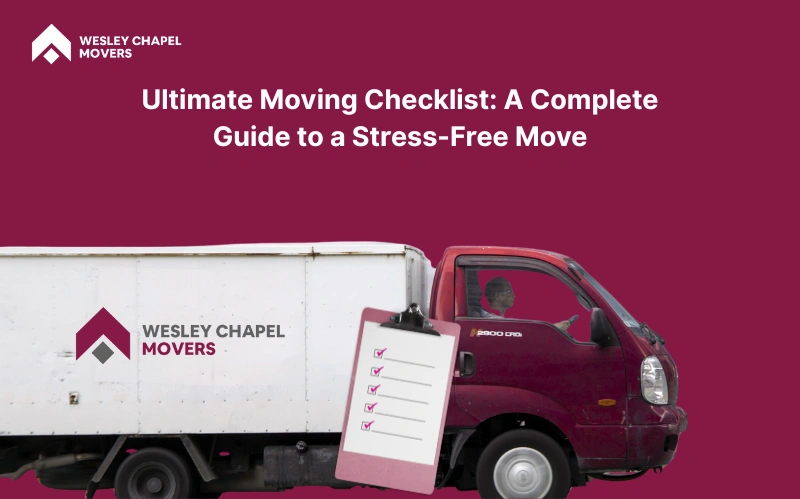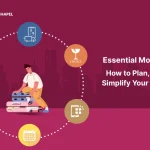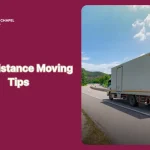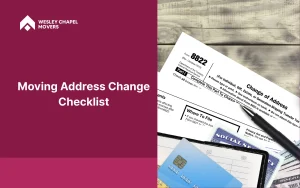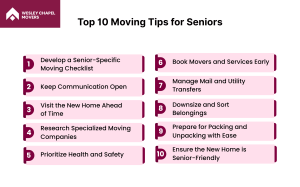A moving checklist is a practical planning tool that organizes every task involved in relocating to a new home or office. It breaks down the process into clear, time-based steps such as budgeting, decluttering, packing, securing transportation, and updating services. With each task accounted for in sequence, a checklist gives structure to what is typically a high-stress experience.
Moving can feel overwhelming because it requires managing countless details and making timely decisions. Without a structured approach, important steps may be overlooked or delayed. This guide offers a comprehensive checklist to support you through every stage of the move. It lays out a logical path from early preparation to final unpacking, helping you stay organized and in control.
To stay on track, use this moving checklist as your go-to guide from the moment you begin planning until you are fully settled in. It walks you through key phases like scheduling, packing, transportation, address updates, and setting up your new space. When followed step by step, it reduces stress, prevents setbacks, and boosts your confidence throughout the moving process.
Planning and Preparation: Laying the Groundwork
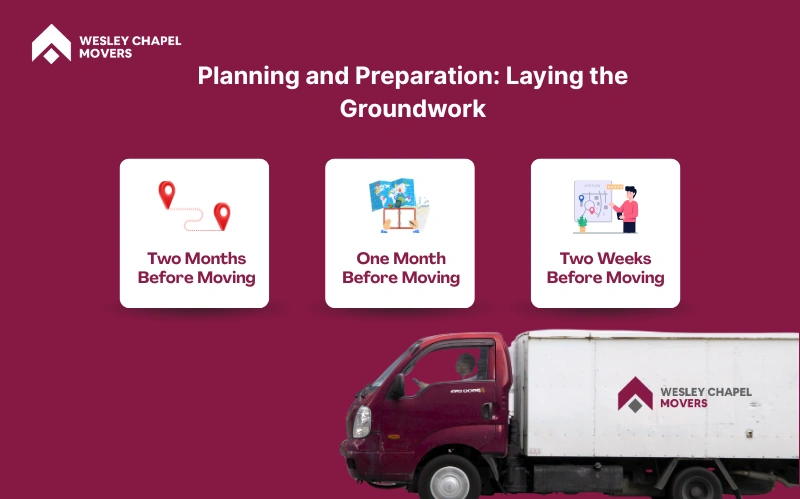
You need to start planning at least two months in advance for a stress-free and successful relocation. Early preparation gives you time to create a budget, compare moving services, and schedule your move on your terms. It also allows you to sort belongings, decide what to keep or discard, and begin organizing each room. By planning ahead, you avoid last-minute decisions and reduce the risk of delays, added costs, or forgotten tasks.
Two Months Before Moving
Begin your moving process two months ahead to stay in control and avoid last-minute decisions. At this early stage, you can focus on building a clear plan, organizing your home, and setting a realistic budget. These steps lay the groundwork for everything that follows and give you time to compare your moving options. To move forward efficiently, begin with the following tasks:
- Create a personalized moving checklist to track tasks and deadlines.
- Sort and declutter your belongings by category. For example, donate unused kitchen appliances or old clothes.
- Set a moving budget that includes services, supplies, and travel.
- Research and compare moving companies or rental trucks by checking online reviews and getting quotes
- Decide whether to hire professionals or move yourself based on distance, budget, and time.
- Book your moving date early to secure availability, especially during weekends or peak seasons.
One Month Before Moving
With one month left, your focus should shift to confirming details and taking tangible steps. This is the ideal time to start packing items you rarely use and to notify key contacts about your upcoming move. Tackling these tasks now gives you breathing room later and ensures nothing is rushed. Use the list below to guide your next actions:
- Confirm your moving company or truck rental details, including pickup time and insurance.
- Start packing non-essential items like off-season clothing, books, and decor.
- Notify your landlord or HOA of your move-out date to avoid penalties or miscommunication.
- Use up perishable food and cleaning products to avoid waste. Plan meals using freezer and pantry items.
- Purchase extra boxes, bubble wrap, and markers if current supplies are running low.
- Make a list of people and services to notify, such as your employer, banks, and subscription accounts.
Two Weeks Before Moving
At the two-week mark, it is important to start finalizing your move. Your attention should turn to packing essentials, transferring utilities, and reviewing key logistics. Completing these steps now will help you avoid last-minute issues and keep your move on schedule. Focus on the following tasks to stay organized:
- Pack a box of essentials for the last days and moving day. Include toiletries, chargers, medications, and basic kitchen tools.
- Confirm cancellation dates for current utilities like electricity, water, and internet to avoid overlapping charges.
- Set up new utilities at your next location so services are active on move-in day.
- Arrange any time off from work to handle moving day without distractions.
- Double-check logistics, such as elevator bookings or parking permits, if moving from an apartment.
- Back up important digital files and pack personal documents like IDs, leases, and financial records in a safe place.
Packing: Safeguarding Your Belongings
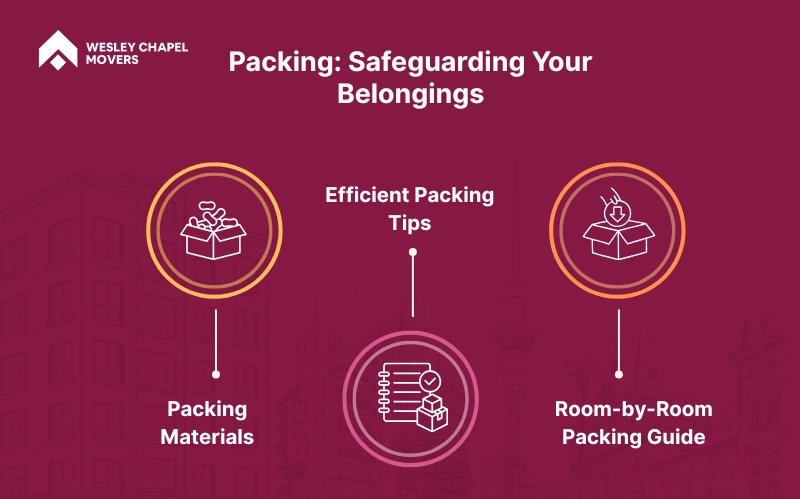
Smart packing protects your belongings and simplifies both the move and unpacking process. The right materials prevent breakage and reduce the risk of damage in transit. Labeling and organized packing make it easier to find what you need and avoid confusion later. Disassembling furniture saves space and prevents wear during transport, while an essentials box ensures comfort and access to daily items from the moment you arrive.
Packing Materials
Choosing the right packing materials is key to protecting your items and making the move more manageable. Durable supplies prevent damage, keep items secure in transit, and make stacking and carrying boxes easier. Matching materials to your items improves safety and efficiency. To get started, make sure you have the following:
- Small, medium, and large boxes
- Heavy-duty packing tape
- Bubble wrap or foam sheets
- Stretch wrap
- Dish barrels and cell dividers
- Packing paper or clean towels
- Permanent markers and color-coded labels
Efficient Packing Tips
Efficient packing makes a big difference in both time and effort. It helps reduce the number of boxes, protects your belongings, and speeds up setup in your new space. Adopting a clear method improves organization from start to finish. Here are some practical tips to pack smarter:
- Pack items by room so they can be unpacked in a logical order.
- Use luggage and plastic bins for heavier items like books or tools to avoid overloading boxes.
- Label all sides of each box to identify its contents without having to shift stacks.
- Fill empty spaces with soft items like towels or crumpled paper to prevent items from moving.
- Use transparent bins for essentials so they are easy to find upon arrival.
- Limit box weight to around 40 to 50 pounds to make lifting safer and more manageable.
- Photograph the electronics setup, like TVs or routers, before unplugging for quick reassembly.
Room-by-Room Packing Guide
Packing one room at a time reduces confusion and keeps your move organized. It allows you to track progress more easily and ensures each space is handled thoroughly. Starting with less-used areas helps build momentum while keeping daily life uninterrupted. Follow this approach to stay efficient:
- Start with storage areas such as basements, attics, and closets, where items are already packed away.
- Box up seasonal items and decorations that won’t be needed before the move.
- In bedrooms, begin with non-essential clothes and backup linens.
- In kitchens, pack seldom-used tools and appliances first, saving essentials for last.
- Clearly label fragile kitchen boxes and use padding between stacked items.
- In bathrooms, sort and pack backup toiletries, extra towels, and unused supplies.
- Prepare an essentials kit for each family member with must-haves for the first night.
Logistics and Transportation: Getting Things to Your New Home
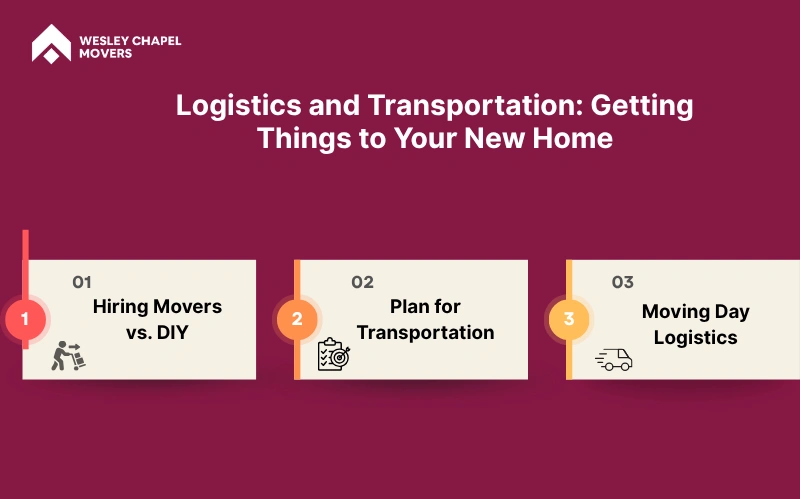
A well-planned moving day begins with reliable transportation and clear logistics. The way you organize the move, whether by hiring professionals or managing it yourself, affects both the safety of your belongings and the pace of the day. Taking time to coordinate routes, loading order, and access points helps prevent delays and ensures everything arrives safely.
Hiring Movers vs. DIY
Choosing between hiring movers and doing it yourself depends on your budget, time, and how complex the move is. Professional movers reduce physical effort and speed up the process, while a DIY move offers flexibility and potential savings. To decide what suits your situation best, consider the following:
- Evaluate the size and distance of your move. Use movers for large homes or cross-country relocations.
- Compare total costs, including truck rental, gas, tolls, and equipment if moving on your own.
- Assess physical demands, such as lifting heavy items or navigating stairs.
- Review your timeline, especially if you are on a tight schedule or juggling work responsibilities.
- Check the mover’s credentials, licenses, and reviews if you choose a professional service.
- Determine how much help you will have if planning a DIY move with friends or family.
Plan for Transportation
A clear transport plan helps avoid delays and protects your belongings during the move. Planning how to load, route, and access both locations improves efficiency and prevents surprises. Keep the following steps in mind when preparing:
- Map out the route between your current and new home and plan for any traffic or road closures.
- Measure large furniture and doorways to avoid issues on moving day.
- Create a loading order so the most essential items are easy to unload first.
- Label fragile boxes clearly and load them in a stable, protected position.
- Secure moving equipment like dollies, straps, and furniture blankets in advance.
- Review parking or elevator access at both locations to avoid last-minute obstacles.
Moving Day Logistics
A well-organized moving day keeps everything on track. Coordinating tasks, managing access, and staying alert helps prevent confusion and missed steps. Follow these actions to keep the day running smoothly:
- Start early to leave room for unexpected delays.
- Assign roles to anyone helping so tasks do not overlap or get missed.
- Supervise loading to ensure fragile and high-value items are handled properly.
- Double-check each room before leaving to make sure nothing is left behind.
- Keep personal essentials with you, such as documents, valuables, and medications.
- Track boxes using a checklist or inventory sheet for easier unpacking later.
Address Changes and Notifications: Keeping Things on Track
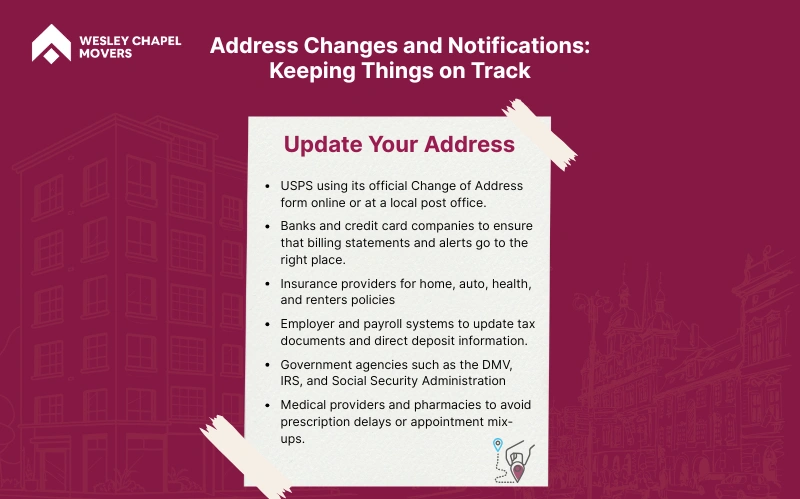
Timely address updates help prevent missed mail, delayed bills, and service disruptions after your move. When you notify key contacts, such as the postal service, utility companies, banks, and insurance providers, you maintain uninterrupted access to essential communications and services. Handling these updates early keeps your transition organized and avoids problems once you are in your new home.
Update Your Address
Start your address updates with essential institutions that affect mail, money, and legal records. These changes are time-sensitive and should be handled before or immediately after moving to avoid lapses in communication or service. Make sure to notify the following:
- USPS using its official Change of Address form online or at a local post office.
- Banks and credit card companies to ensure that billing statements and alerts go to the right place.
- Insurance providers for home, auto, health, and renters policies.
- Employer and payroll systems to update tax documents and direct deposit information.
- Government agencies such as the DMV, IRS, and Social Security Administration.
- Medical providers and pharmacies to avoid prescription delays or appointment mix-ups.
Post-Move Tasks: Wrapping It Up
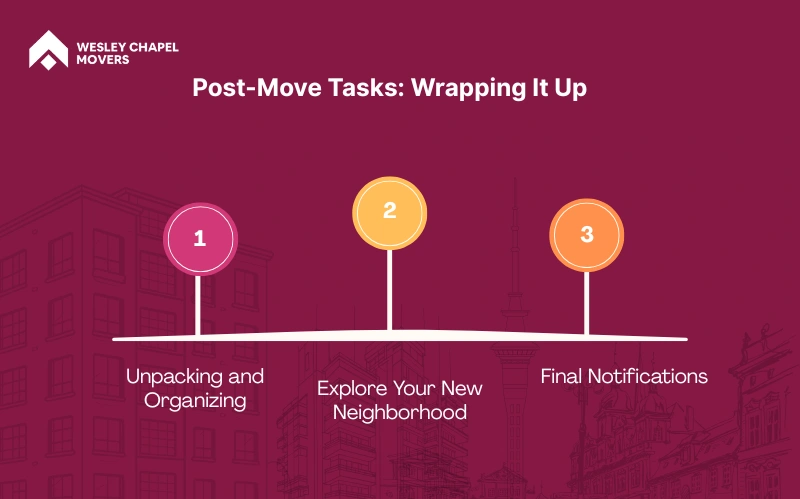
Once the move is complete, there are still a few important steps to ensure your new home is fully functional and comfortable. Taking time to unpack efficiently, organize your space, and finalize remaining notifications helps you settle in with less stress. Handling these tasks early also creates a clean start and supports a smoother adjustment to your new environment.
Unpacking and Organizing
A structured unpacking process helps you settle in faster and keeps your new space functional from the start. Instead of opening boxes at random, unpack with intention to avoid mess and confusion. Begin with these foundational tasks to make the process smoother:
- Begin with essential rooms such as the kitchen, bathroom, and bedroom.
- Set up furniture first to create structure and make space for unpacking.
- Unpack essential boxes with daily-use items like toiletries and chargers.
- Break down boxes as you go to keep your space clear.
- Group similar items during unpacking to streamline storage and reduce duplicates.
- Declutter again as you unpack by setting aside items you no longer need.
Explore Your New Neighborhood
Learning your surroundings helps you build routines and feel at home more quickly. Getting familiar with nearby services and connecting with neighbors creates a sense of belonging. Start with the steps below to make your new area feel familiar:
- Take a walk around your block to get a feel for the layout and local spots.
- Locate essential services such as grocery stores, gas stations, and pharmacies.
- Visit nearby schools or parks if you have children or pets.
- Introduce yourself to neighbors for helpful insights and local tips.
- Note nearby transportation options if you use public transit.
- Find local healthcare providers and update your contact list.
Final Notifications
Finishing your move includes handling a few final details that are easy to overlook. These last tasks ensure everything is updated, returned, and ready for the next chapter. Check off the following to fully close out your move:
- Double-check address changes with financial institutions, insurance providers, and subscriptions.
- Return any borrowed items, such as tools or storage containers.
- Dispose of packing materials responsibly or donate usable boxes.
- Update your voter registration with your new address.
- Check for unforwarded mail using USPS Informed Delivery or a visit to your old address.
- Keep receipts and records for moving expenses in case of tax or reimbursement needs.
Connect with Professional Moving Services for a Seamless Transition
Handling a move on your own can quickly become overwhelming, especially when balancing packing, logistics, and time constraints. Professional movers simplify the process by managing each stage with care, allowing you to focus on settling in rather than managing every detail yourself.If you are looking for a trusted mover company, Wesley Chapel Movers offers complete moving services, including packing, loading, local and long-distance transport, and secure storage solutions in Wesley Chapel and nearby Florida communities. We handle apartment moves, full-house relocations, office transitions, and specialty item transport such as pianos or antiques. Our team is trained to execute every type of move with precision, timeliness, and respect for your property. To get started, contact us for a personalized estimate or schedule your move with our team today.
